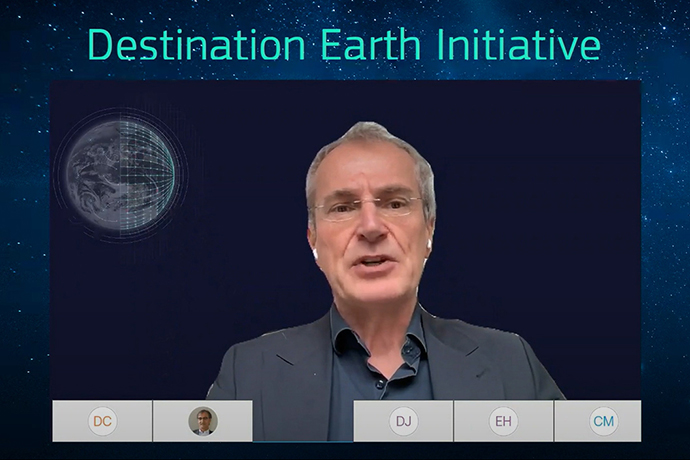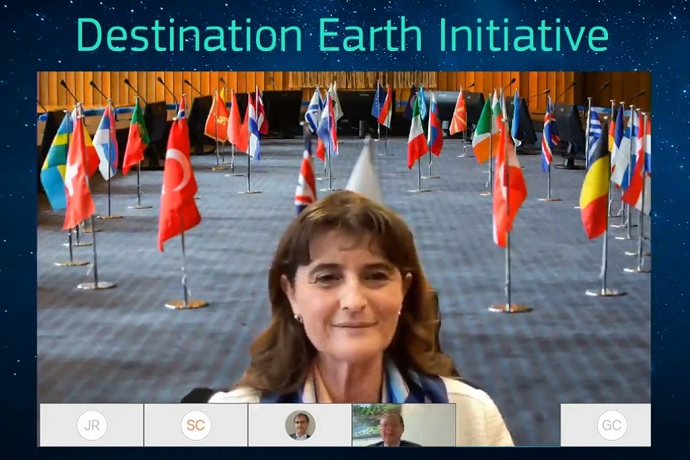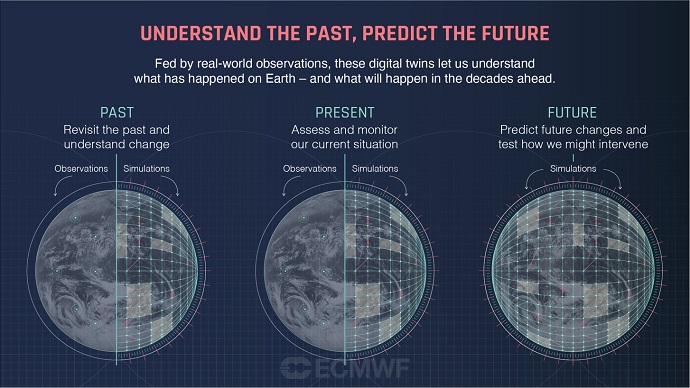

ECMWF’s Director of Destination Earth, Peter Bauer, gave a presentation at the European Commission’s event to launch the initiative.
Representatives of the European Space Agency (ESA), EUMETSAT, ECMWF and the European Commission came together virtually on 30 March 2022 to inaugurate Destination Earth (DestinE), an ambitious initiative to develop a highly accurate digital twin of our planet.
With the existing Copernicus Programme and the newly created DestinE initiative, Europe is equipping itself with the tools, infrastructure and capability to better plan and act for our planet's future.
Contribution agreements for DestinE were signed between the three organisations and the European Commission in December. The ECMWF contribution agreement covers the first 30 months of a seven- to ten-year programme that promises to be transformational for how European society will be able to deal with the impacts of a changing climate and weather extremes.
Aims
DestinE is a ground-breaking initiative that brings together scientific and digital technology excellence from across Europe to develop a highly accurate digital replica of the Earth. It has the potential to profoundly change people’s understanding of our planet, to explain the causes and effects of change, and crucially to help design actions to adapt our society and manage risks.
ECMWF Director-General Florence Rabier said: "Destination Earth will be a platform where risk planning, mitigation measures and adaptation actions can be demonstrated. This will eventually benefit users of operational services, such as those in Copernicus, national meteorological services, and others as the outcomes of Destination Earth come to be integrated as part of their evolution."

ECMWF Director-General Florence Rabier explained the importance of DestinE at the European Commission's event to launch the initiative.
The initiative will support the European Commission’s Green Deal priority actions on climate change, biodiversity and deforestation. It will also help monitor food security, changes in the polar regions and global sea level rise.
DestinE also contributes to Europe’s digital strategy, which is focused on data, technology, and infrastructure.

Means
DestinE will rely on advanced digital technologies at the core of high-performance and cloud computing, big data handling, artificial intelligence and machine learning. It will also include new types of observations from commodity devices like mobile phones and the internet of things.
These technologies will become an integral part of ECMWF’s future digital twin engine (DTE), ESA’s core service platform and EUMETSAT’s data lake. The core service platform provides an open access portal to tools and a virtual, comprehensive data repository, the data lake. Users can interact with the platform and tailor their own workflows and data driven models to their specific needs, whether they are scientists, commercial enterprises or policy makers.
ECMWF’s DTE will consist of generic workflows performing Earth-system simulations and simulation-observational data fusion at very high spatial resolutions. It will have sufficient computational throughput to serve the prediction of extremes and climate adaptation applications.
Applications targeting water, energy, food, health and risk management will be integrated into the engine as much as possible. "The aim will be to support the seamless transition from data to information, from information to insights, and from insights to actions," says ECMWF's Director of Destination Earth, Peter Bauer.
In the first years of the programme, the DTE will feed two high-priority digital twins on weather-induced extremes and climate change adaptation. These are topics of outstanding societal importance where ECMWF can contribute almost five decades of world-leading scientific expertise.
Ultimately, DestinE will revolutionise the European capability to monitor and predict our changing planet. This capability will be enabled by the integration of extreme-scale computing and the real-time exploitation of the full breadth of available environmental data.

Outcomes
At the heart of DestinE will be digital models of the Earth. These will replicate our own world but allowing interaction and scenario-playing: users will be able to change just a single aspect and explore the results.
Modern technology is now able to support the development of such a replica, and researchers are on the brink of creating our planet’s first digital twin. This will allow unprecedented insight into the past, present and future state of the Earth and the consequences of our actions on potential futures.
Digital twins have been used for some time in fields such as engineering to understand how to optimise and maintain real-life processes or assets, for example in smart cities or factory production. Applying this technology to build a replica Earth is now possible thanks to the transforming power of exascale computing and data handling, also in the cloud, building on simulation and data-fusion techniques that have been developed over many decades for use with weather and climate prediction.
The DestinE digital twins will push this approach further than ever, producing near real-time, highly detailed and constantly evolving models of the Earth, including impacts from human activities.
Observations will come from a multitude of sources, both traditional and novel. Ultimately, individual digital twins will be combined to build a highly complex model of the Earth system which will be more detailed than anything seen before, and can be tailored to all applications relevant for society.
Outlook
New approaches from machine learning and artificial intelligence will be used to improve the realism and efficiency of these digital representations of our world, making them a vital tool to help solve some of our planet’s most pressing challenges.
Theory and technology are constantly developing, with advances coming faster than ever before. The methodologies behind digital twins must be able to react to these changes, and this can only be achieved through cooperation of Earth system specialists, computer scientists and experienced data users from a range of sectors.
"The programme is hugely ambitious, and the extensive development required means it can only be built up slowly over several years, yet each phase promises to bring a big change to the way that climate and weather forecasting are carried out," Peter Bauer says. "Our understanding of the present, and simulation and evaluation of potential futures, will be changed beyond recognition."
The European Commission has issued a press release on the launch of DestinE.
A recording of the virtual event on 30 March 2022 and a Destination Earth Factsheet are also available.
